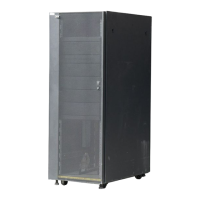2) Circulate the cleaning solution for a minimum of 30 minutes (longer if time permits) to ensure
that it reaches all sections of the system.
3) Drain the system completely, disposing of the cleaning solution according to local regulations
4) Rell with demineralized water, reverse osmosis water, deionized water, or distilled water.
5) Circulate the water for 15 minutes.
6) Drain the system completely, disposing of the cleaner according to local regulations.
7) Immediately proceed to ll the system with water that contains premixed inhibitor and
preservative.
b. Cleaning with deionized water. This procedure can be used if the cleaning chemical cannot be
obtained or if local laws prevent the disposal of the chemicals.
1) Completely ll the system with demineralized water, reverse osmosis water, deionized water, or
distilled water.
2) Deionize the water by bypassing some of the water flow through the deionizing cartridge or
cartridges and circulate the water normally through the complete system until the resistivity of
the water increases above 1 MΩ cm.
3) Proceed to the inhibitor dosing procedure.
Use the following procedure for chemical dosing:
1. Install a new or cleaned 50 μm lter in the lter housings.
2. One of the following two dosing procedures can be used:
a. If the system was cleaned by using cleaning solution Nalco 460-CCL2567 or Nalco CCL2567 and if
at the end of the “Initial treatment for systems smaller than 75.7 liters (20 gallons)” on page 164
procedure, the system was empty with no water in it, complete the following steps:
1) Fill the coolant reservoir with Nalco 460PCCL100 / Nalco CCL100. Add 120 ppm of Nalco
3DT-199 to raise the azole concentration to 40 ppm.
2) If bacteria or fungi is suspected or is a serious concern, add one of the following biocides:
• 100 parts per million (ppm) of Nalco H-550 (glutaraldehyde)
• 200 ppm of Nalco 73500 (glutaraldehyde)
• 100 ppm of Nalco 77352 (isothiazolone)
The choice of biocide depends on the expected microbiological material in the cooling loop.
Glutaraldehyde biocide is more effective against anaerobic bacteria. Isothiazolone is more
effective against aerobic bacteria, fungi, and algae. When in doubt, use the isothiazolone
biocide.
3) Conrm azole residual using Nalco azole test kit.
If the system was cleaned by using deionized water only and the system is full of deionized water,
complete the following steps:
1) Add one of the following biocides:
• 100 parts per million (ppm) of Nalco H-550 (glutaraldehyde)
• 200 ppm of Nalco 73500 (glutaraldehyde)
• 100 ppm of Nalco 77352 (isothiazolone)
The choice of biocide depends on the expected microbiological material in the cooling loop.
Glutaraldehyde biocide is more effective against anaerobic bacteria. Isothiazolone is more
effective against aerobic bacteria, fungi, and algae. When in doubt, use the isothiazolone
biocide.
2) Add 120 ppm of Nalco 3DT-199 to achieve 40 ppm azole concentration.
3) Conrm azole residual using Nalco azole test kit.
Racks and rack features
165

